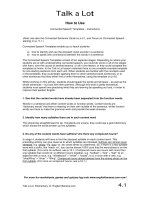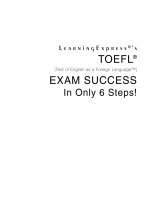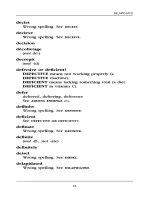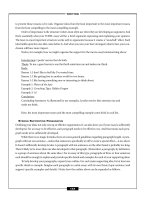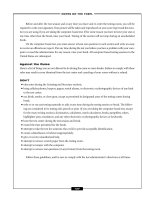Success step english 6 doc
Bạn đang xem bản rút gọn của tài liệu. Xem và tải ngay bản đầy đủ của tài liệu tại đây (109.69 KB, 6 trang )
Sample Question:
Finding Part of a Whole
11. There are 500 flights out of Los Angeles every
hour. Five percent are international flights. How
many international flights leave Los Angeles
every hour?
Answer
1. You are being asked to find a part of the 500
flights. The 500 flights is the whole. The percent
is 5. You need to find the part. 5% is fairly small,
and considering that 20% of 500 is 100, you
know your answer will be less than 100.
2. The second sentence has an implied pronoun.
The sentence can be rephrased “Five percent of
them are international flights.” “Them” refers to
the number 500.
3. The question is “How many ”Use the other
sentences to reconstruct the question so it
includes all the necessary information. The
problem is asking “5% of 500 (them) are how
many (international flights)?” The question is
now conveniently set up.
4. “Are” is the verb. 500 and 5% are on the left side
of the verb and “how many” is on the right side.
“How many” is all by itself, so it goes on top of
the ratio in the form of a variable. 500 is next to
the of so it goes on the bottom. At this point,
check to see that the part is over the whole.
ᎏ
50
x
0
ᎏ
=
5. The 5 goes over 100.
ᎏ
50
x
0
ᎏᎏ
1
5
00
ᎏ
6. The two are equal to each other.
ᎏ
50
x
0
ᎏ
=
ᎏ
1
5
00
ᎏ
7. Solve.
8. 25 international flights leave every hour.
Sample Question: Finding the Whole
12. In a certain laboratory, 60%, or 12, of the mice
worked a maze in less than one minute. How
many mice were there in the laboratory?
Answer
Once again, follow the eight Success Steps to solving
this problem.
1. 12 is part of the total number of mice in the lab-
oratory. 60 is the percent, which is more than
half. 12 must be more than half of the whole.
2. There are no pronouns.
3. The problem is asking, “60% of what number
(total mice) is 12?”
4. “Is” is the verb. The 12 is all by itself on the right
of the verb.“What number” is next to the of.The
12 goes on top, the variable on the bottom.
ᎏ
1
x
2
ᎏ
5. The 60 goes over 100.
ᎏ
1
6
0
0
0
ᎏ
6. The two fractions are equal to each other.
ᎏ
1
x
2
ᎏ
=
ᎏ
1
6
0
0
0
ᎏ
7. Solve.
8. There were 20 mice in the laboratory.
Sample Percent Question
13. Courtney sold a car for a friend for $6,000. Her
friend gave her a $120 gift for helping with the
sale. What percent of the sale was the gift?
3
1
==
20
12 100
60
×
12 100
60
×
4
5
500
1
5
100
==
25
×
500 5
100
×
5
–CBEST MINI-COURSE–
113
Answer
1. 6,000 is the whole and 120 the part.
2. There are no pronouns, but there are words that
stand for numbers. In the question at the end, the
sale is 6,000 and the gift is 120.
3. The question is written out clearly: “What percent
of 6,000 (sale) was 120 (gift)?”
4. “Was” is the verb. 120 is by itself on one side. It is
the part, so it goes on top. 6,000 is near the of and
is the whole, so it goes on the bottom.
ᎏ
6
1
,0
2
0
0
0
ᎏ
5. There is no percent so x goes over 100.
ᎏ
10
x
0
ᎏ
6. The two equal each other.
ᎏ
6
1
,0
2
0
0
0
ᎏ
=
ᎏ
10
x
0
ᎏ
7. Solve.
8. The gift was 2% of the sale.
Sample Percent Change Question
A change problem is a little bit different than a basic
percent problem. To solve it, just remember change
goes over old:
ᎏ
ch
o
a
l
n
d
ge
ᎏ
.
14. The Handy Brush company made $500 million
in sales this year. Last year, the company made
$400 million. What was the percent increase in
sales this year?
Answer
First of all, what was the change in sales? Yes, 100 mil-
lion. You got that by subtracting the two numbers.
Which number is the oldest? Last year is older than this
year, so 400 is the oldest. Therefore, 100 goes over 400.
ᎏ
1
4
0
0
0
0
ᎏ
The percent is the unknown figure, so a variable
is placed over 100 and the two are made equal to each
other. Cross multiply and solve for x.
The answer is 25%. Note that if you had put 100
over 500, your answer would have come out differ-
ently.
Sample Interest Question
15. How much interest will Jill earn if she deposits
$5,000 at 3% interest for six months?
Answer
Interest is a percent problem with time added. The
formula for interest is I = PRT. I is the interest. P is the
principal, R is the rate or percent, and T is the time in
years. To find the interest, you simply multiply every-
thing together. Be sure to put the time in years. You
may change the percent to a decimal, or place it over
100.
$5,000 (principal) × 0.03 (percent) ×
ᎏ
1
2
ᎏ
(year) = $75.
Math 7: Algebra
Algebra is like a perfectly balanced scale. The object is
to keep both sides balanced while isolating the part you
need on one side of the scale. For example, suppose
you know a novel weighs 8 ounces and you want to
find out how much your thick phone book weighs. You
have five novels on one side of the scale, and your
phone book and two novels on the other side. They
perfectly balance. By taking two novels off each side,
your phone book is alone and perfectly balances with
the three novels on the other side. Then you know that
your phone book weighs 3 × 8, or 24 ounces.
===
25
100
400
100
4
x
100
100 100
400
×
100
1
==
2
120 100
6,000
×
120 100
6,000
×
2
1
–CBEST MINI-COURSE–
114
Plugging in Numbers
There are several types of algebra problems you may
see on the CBEST. The first consists of a formula, per-
haps one you have never seen, such as Y = t + Z − 3z.
You think, “I have never seen this . . .” and you are
tempted to skip it. But wait you read the question:
What is Y if t = 5, Z = 12, and z = 1? All you do is plug
in the numbers and do simple arithmetic.
Y = t + Z − 3z
Y = 5 + 12 − 3(1) = 14
Sample Question
1. Given the equation below, if t = 5 and h = 7,
what is Q?
Q = t
2
− 3h
Answer
You were right if you said 4.
Q = t
2
− 3h
Q = 5
2
− 3(7)
Q = 25 − 21 = 4
Solving an Equation
In the second type of question, you may actually be
called upon to do algebra.
Sample Algebra Question
2. Given the equation below, if Q = 15 and h = 1,
what is the value of t?
Q = t − 3h
Answer
First, plug in the numbers you know and do as much
arithmetic as you can:
Q = t − 3h
15 = t − 3(1)
15= t − 3
1. What numbers are on the same side as the vari-
able? 3
2. How are the numbers and the variable connected?
With a minus sign.
3. The Opposite is what? Addition.
With that, add 3 to both sides to get your answer:
15 = t − 3
+3 +3
18 = t
Practice
Try these problems. You can probably do them in your
head, but it’s a good idea to practice the algebra
because the problems get harder later.
3. 3x = 21
4. 6 + x = 31
5. x − 7 = 24
6.
ᎏ
3
x
ᎏ
= 9
7.
ᎏ
1
3
ᎏ
x = 5
Three Success Steps
for Algebra Problems
In order to make a problem less confusing, try
the WHO method:
1. What numbers are on the same side as the
variable? There are two sides of the equal
sign, the right side and the left side.
2. How are the numbers and the variable
connected?
3. The Opposite is what? The opposite of sub-
traction is addition.
–CBEST MINI-COURSE–
115
Answers
3. x = 7
4. x = 25
5. x = 31
6. x = 27
7. x = 15
Other Operations You Can Use
The following are some other ways you can manipulate
algebra on the CBEST.
Square Both Sides
When you’re faced with a problem like ͙x
ෆ
= 5, you
have to get x out from under the square root sign in
order to solve it. The way to do this is to square both
sides of the equation. Squaring is the opposite of a
square root, and cancels it.
͙x
ෆ
= 5
͙x
ෆ
2
= 5
2
x = 25
Take the Square Root of Both Sides
If the variable is squared, take the square root of both
sides.
x
2
= 25
͙x
ෆ
2
= ͙25
ෆ
x = 5
Flip Both Sides
If the answer calls for x and the x ends up as a denom-
inator, the answer is unacceptable as is, because the
question called for x, not
ᎏ
1
x
ᎏ
. If you have gotten this far
in a problem, you can find the answer easily by flipping
both sides.
ᎏ
1
x
ᎏ
=
ᎏ
6
7
ᎏ
ᎏ
1
x
ᎏ
=
ᎏ
7
6
ᎏ
x =
ᎏ
7
6
ᎏ
or 1
ᎏ
1
6
ᎏ
Divide by a Fraction
To divide by a fraction, you take the reciprocal of the
fraction and multiply.
ᎏ
3
5
ᎏ
x = 15
Since the reciprocal of
ᎏ
3
5
ᎏ
is
ᎏ
5
3
ᎏ
, multiply both sides
by
ᎏ
5
3
ᎏ
:
(
ᎏ
5
3
ᎏ
)
ᎏ
3
5
ᎏ
x = 15(
ᎏ
5
3
ᎏ
)
x =
ᎏ
1
1
5
ᎏ
(
ᎏ
5
3
ᎏ
)
Reduce the fractions and multiply:
Practice
Solve for x:
8. x
2
= 144
9. ͙x
ෆ
= 7
10.
ᎏ
1
x
ᎏ
=
ᎏ
3
4
ᎏ
11.
ᎏ
2
3
ᎏ
x = 14
Answers
8. 12
9. 49
10.
ᎏ
4
3
ᎏ
or 1
ᎏ
1
3
ᎏ
11. 21
==
25
15
5
3
x
1
(
)
5
1
–CBEST MINI-COURSE–
116
Multi-Step Problems
Now that you have mastered every algebraic trick you
will need, let’s juggle them around a little by doing
multi-step problems. Remember the order of opera-
tions: Please Excuse My Dear Aunt Sally—Parenthe-
ses, Exponents, Multiply and Divide, Add and
Subtract? That order was necessary when putting
numbers together. In algebra, numbers are pulled
apart to isolate one variable. In general, then, it is eas-
ier to reverse the order of operations—add and sub-
tract, then multiply and divide, then take square roots
and exponents. Here is an example:
35 = 4x − 3
In this problem, you would add the 3 to both
sides first. There is nothing wrong with dividing the 4
first, but remember, you must divide the whole side
like this:
ᎏ
3
4
5
ᎏ
=
ᎏ
4x
4
− 3
ᎏ
or
ᎏ
3
4
5
ᎏ
=
ᎏ
4
4
x
ᎏ
−
ᎏ
3
4
ᎏ
As you can see, by adding first, you avoid work-
ing with fractions, making much less work for yourself:
35 = 4x − 3
+3 +3
38 = 4x
Then divide both sides by 4 resulting in the
answer:
x =
ᎏ
1
2
9
ᎏ
= 9
ᎏ
1
2
ᎏ
Practice
Try these:
12. 5y − 7 = 28
13. x
2
+ 6 = 31
14.
ᎏ
4
5
ᎏ
x − 5 = 15
15. If a − 2b = c, what is a in terms of b and c?
Hint: When a question calls for a variable in
terms of other variables, manipulate the equa-
tion until that variable is on a side by itself.
16. If
ᎏ
p
3
ᎏ
+ g = f, what is p in terms of g and f?
Answers
12. y = 7
13. x = 5
14. x = 25
15. a = c + 2b
16. p = 3(f − g)
Problems Involving Variables
Sometimes you’ll find a problem on CBEST that has
almost no numbers in it.
Sample Variable Question
17. John has 3 more than 10 times as many students
in his choir class than Janet has in her special
education class. If the number of students in
John’s class is v, and the number in Janet’s class is
s, which of the equations below does NOT
express the information above?
a. v = 3 + 10s
b. v − 3 = 10s
c.
ᎏ
v
1
−
0
3
ᎏ
= s
d. 10s − v = −3
e. v + 3 = 10s
=
38
2
4
4x
4
19
–CBEST MINI-COURSE–
117
Answer
After reading question 17, you’re likely to come up
with the equation in answer a. Since a is correct, it is
not the right choice. Now manipulate the equation to
see whether you can find an equivalent equation. If
you subtract 3 from each side, answer b will result.
From there, dividing both sides by 10, you come up
with c. All those are equivalent equations. Choice d can
be derived by using b and subtracting v from both
sides. Choice e is not an equivalent and is therefore the
correct answer.
Distance, Rate, and
Time Problems
One type of problem made simpler by algebra are
those involving distance, rate, and time. Your math
review would not be complete unless you had at least
one problem about trains leaving the station.
Sample Distance Problem
18. A train left the station near your home and went
at a speed of 50 miles per hour for 3 hours. How
far did it travel?
a. 50 miles
b. 100 miles
c. 150 miles
d. 200 miles
e. 250 miles
Answer
Use the three Success Steps to work through the
problem.
1. D = R × T
2. D = 50 × 3
3. 50 × 3 = 150
Practice
Try these:
19. How fast does a dirt bike go if it goes 60 miles
every 3 hours?
20. How long does it take to go 180 miles at 60 miles
per hour?
Answers
19. R = 20
20. T = 3
HOT TIP
Another way to look at the distance formula is
When you’re working out a problem, cross out the let-
ter that represents the value you need to find. What
remains will tell you the operation you need to perform
to get the answer: the horizontal line means divide and
the vertical line means multiply. For example, if you
need to find R, cross it out. You’re left with D and T.
The line between them tells you to divide, so that’s
how you’ll find R. This is a handy way to remember the
formula, especially on tests, but use the method that
makes the most sense to you.
Three Success Steps for Distance,
Rate, and Time Problems
1. First, write the formula. Don’t skip this step!
The formula for Distance, Rate, and Time is D
= R × T. Remember this by putting all the let-
ters in alphabetical order and putting in the
equal sign as soon as possible. Or think of the
word DIRT where the I stands for is, which is
always an equal sign.
2. Fill in the information.
3. Work the problem.
–CBEST MINI-COURSE–
118
D
R T
